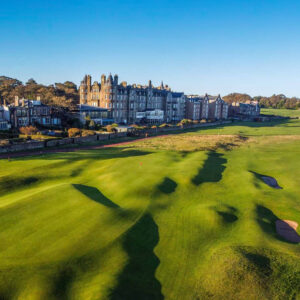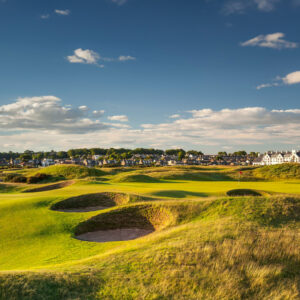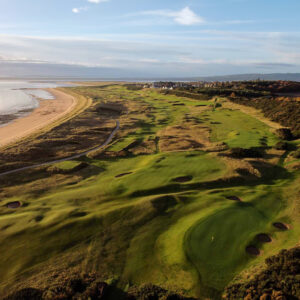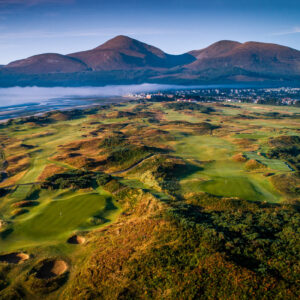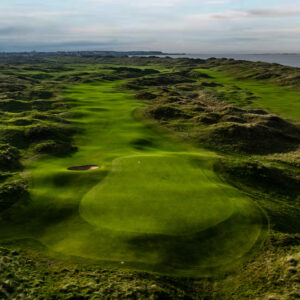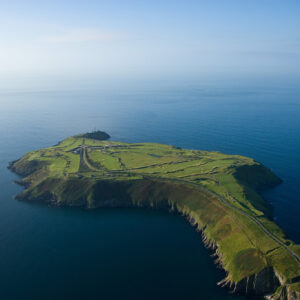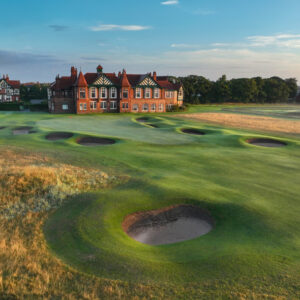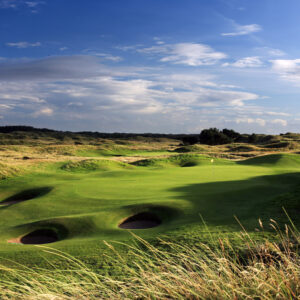The great Peter Thomson had a lifelong affection for the finest golf courses of the United Kingdom and Ireland.
“Not all of golf’s classic courses belong to Britain and Ireland,” the five-time Open Champion once wrote, “but there is no place on earth where so many of high calibre exist in a pristine state.”
It was always difficult to mount a successful argument against “Thommo” on most subjects, but in this case, it is particularly so. Still, if you don’t believe the great man, consider the evidence.
Depending on what Top-100 Courses ranking list you reference, 30 to 35 percent of courses featured will be from the United Kingdom and Ireland, which is astonishing but, at the same time, not altogether surprising.
After all, it is in the UK and Ireland where the now-ancient sport originated and was nurtured by golf’s forefathers – men like Old Tom Morris, Allan Robertson and the Park clan of Willie Snr, Jnr and Mungo – before later generations took the game to the continent and onward to the rest of the world.
It is in the UK and Ireland where the greatest course designers in the game’s history perfected their craft, creating world-famous seaside links and testing challenges among picturesque heathlands.
And every course you might dream of playing in the UK and Ireland is accessible, including those on The Open Championship rota. Imagine, for a moment, hitting shots from the same turf the game’s greatest players have played off for the past 250 years (or more) as you play the round of a lifetime on the Old Course at St Andrews. Think of that as you walk across the Swilcan Bridge and wander down the 18th fairway back into town … the hairs on the back of your neck will stand on end.
St Andrews is a Mecca to anyone religiously captivated by golf and it lies at the heart of the Home of Golf – Scotland – where you are spoilt for golfing choices no matter where the road ahead leads you.
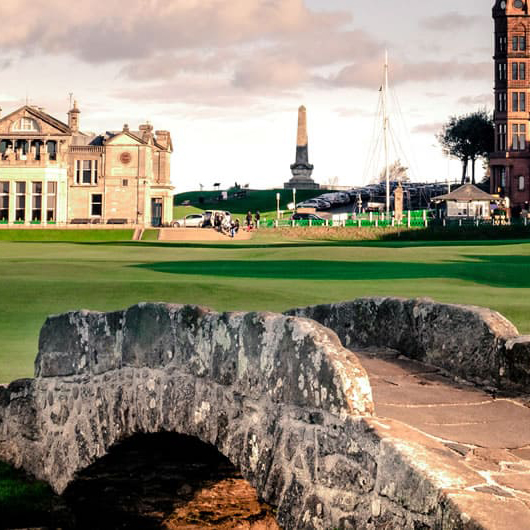
On top of the list are the incredible courses synonymous with the Open Championship to be found within a two-hour drive of the wonderfully historic Edinburgh.
An excursion east following the southern shore of the Firth of Forth will lead you to Muirfield – the home of The Honourable Company of Edinburgh Golfers, which was formed in 1744.
Muirfield’s neighbour, North Berwick, might only be a short drive away, but the two World Top-100 ranked layouts are poles apart in terms of style. Muirfield is an honest, straightforward challenge of the highest quality, while North Berwick is a course of blind shots, shots over stone walls and shots found only when playing by the sea. It is quirky and of the old school, which might be why many describe their round here as “the most fun I’ve ever had on a golf course.”
Travel southwest of the capital to the Ayrshire coast and you will find impressive layouts like Dundonald Links and Western Gailes close to Open Championship hosts Royal Troon, Trump Turnberry and the birthplace of the great Championship, Prestwick. You should take the time to wander through the historic Prestwick clubhouse, check out the memorabilia adorning the walls and enjoy its renowned lunch service.
Touring northeast of Edinburgh it is a similar story with St Andrews in the Kingdom of Fife the inevitable first port of call. While the Old Course is the star of the show here, there are plenty of amazing co-stars like the adjoining New and Jubilee layouts as well as the Castle Course on the edge of town. For a mix of the modern and the ancient, the majestic Kingsbarns, co-host of the DP World Tour’s Dunhill Links, or the seaside beauty of The Golf House Club, Elie – the third oldest course in the world – are just a short drive south of the Auld Grey Toon.
Following Scotland’s east coast north from St Andrews, the challenge of Carnoustie soon beckons, before heading further afield to try and conquer the World Top-100 ranked Royal Aberdeen, Trump International and Cruden Bay, which boasts some of the most exciting seaside holes in Scotland.
- North Berwick
- Carnoustie
- Royal Dornoch
Royal Dornoch is on the road less travelled, but it is certainly worth the time and effort to make the journey. In fact, if not for its remote location, Dornoch would have hosted many Open Championships. It is that good, while recent upgrades and renovations of Old Tom Morris’ original design work have made this inspiring test even better.
Cabot Highlands is home to the acclaimed Castle Stuart course – a spectacular modern links characterised by infinity edge greens and rumpled fairways that overlook the beautiful Moray Firth.
It will be joined later in 2025 by the much-anticipated Old Petty course, created by highly acclaimed American designer Tom Doak. The new course, which takes its name after the adjoining Old Petty Church built in 1839, will lead golfers across spectacular terrain alongside the estuary.
From the west coast of Scotland, it is an easy two-hour ferry trip across the Irish Sea to Northern Ireland and the promise of a royal meeting.
To the south of Belfast there is Royal County Down, regarded by many as the best golf course in the world. A view that won’t draw any argument from four-time major champion and proud Northern Irishman Rory McIlroy.
“This is among my favourite places to play in Northern Ireland,” the local legend said, “it’s one of the truly great links courses. The more you play it, the more you recognise it for the class place it is.”
To the north of the capital is Royal Portrush, which returned to the Open rota to host the 2019 Championship won by Ireland’s Shane Lowry. It was also the venue for the 153rd Open Championship in 2025.
- Royal County Down
- Royal Portrush
- Old Head
Located on the Causeway Coast, Portrush is nestled within a triangle of huge sand hills and golfers are afforded incredible views along the coast towards the landmark Giant’s Causeway to the east and the beautiful rolling hills of County Donegal to the west. There are two courses at Portrush – the excellent Valley layout and the adjoining championship host, Dunluce, named after the 13th century castle, seen from the course. Harry Colt’s Dunluce design is majestic and of all the Open courses it is perhaps the most demanding test of driving because of its narrow fairways lined with wiry, thick, rough. The smallish greens, too, with their tricky slopes offer an exacting test.
Any tour of Ireland must start in Dublin where the welcome is warm, the Guinness is like black gold and the golf is world class.
Topping the bill is Portmarnock, which dates back to the closing years of the 19th century and has since hosted several Irish Opens and the 1960 World Cup won by Sam Snead and Arnold Palmer. There has been some recent speculation that Portmarnock might be added to the Open Championship rota in years to come, which would please Tiger Woods, who once said: “Portmarnock is one of the most enjoyable links courses I have had the opportunity to play.”
If you have a spare afternoon, the nearby Royal Dublin Golf Club is a must-play experience. Australian course architect Mike Clayton has recently completed an extensive renovation of the layout, successfully recapturing some of the best elements of Harry Colt’s original design that had been lost in recent decades.
Almost a quarter of the world’s links courses can be found in Ireland, with the lion’s share of those being scattered along the beautiful, but rugged, southwest coast.
It is here where you will find memorable courses like the Alister MacKenzie-designed Lahinch, the mountainous dunescapes of Ballybunion and Trump International at Doonbeg. This dramatic terrain is also the foundation of the great Ring of Kerry courses at Tralee and Waterville, which Sam Snead once described as “one of the golfing wonders of the world.” One visit and you will agree.
One of the newest additions to the golfing landscape in this part of the world is Ireland’s most spectacular. Old Head Links is laid out across a promontory that protrudes nearly four kilometres into the Atlantic Ocean and sees nine holes lie at the edge of 300-foot-high sandstone cliffs, while all 18 holes offer unsurpassed ocean views.
You should check out nearby Kinsale, considered Ireland’s gourmet capital, before venturing back across the Irish Sea to Wales, where a round at the highly acclaimed links at Royal Porthcawl can be followed by a trip north to Liverpool and England’s Golf Coast.
- Royal Lytham & St Annes
- Royal Birkdale
- Formby
Here, celebrated Open Championship venues – Royal Liverpool, Royal Birkdale and Royal Lytham & St Annes – dot the coast alongside a host of acclaimed layouts including Formby, Hillside and Southport & Ainsdale, which are all regular Open Championship qualifying venues. And be sure to spend a day or two exploring Liverpool, especially if you’re a Beatles fan or your favourite football team happens to play out of Anfield.
London, of course, is one of the world’s greatest cities and, not surprisingly, there is a wide selection of world class golf courses within easy reach including the exclusive Sunningdale and Wentworth clubs in the heart of London’s famed heathland.
The Kent coast, less than two hours’ drive from the centre of London, is home to England’s premier layout – Royal St George’s – where Greg Norman won his second Open Championship in 1993. Its neighbour is Princes, a superb 27-hole links that has been revamped in recent years to more closely resemble the layout where Gene Sarazen claimed the 1932 Open. The third of the great triumvirate in this area is Royal Cinque Ports, a fantastic links that last hosted the Open in 1920 and was almost lost during World War II. Today, all three sit among the Top-100 ranked courses in the world.
And to think, there are dozens, if not hundreds, of courses to be discovered between playing rounds on these superstar layouts, which is what makes the UK and Ireland one of the world’s premier golfing destinations.
Visit our UK & Ireland Golf Holidays page and find some inspiration for your next golf holiday!
